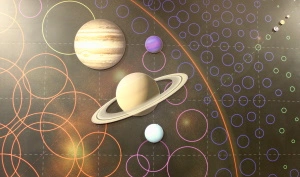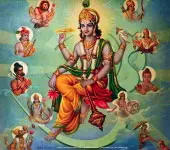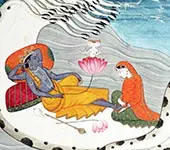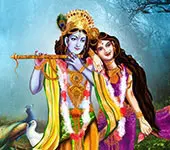This audio tells you about - 1. Meaning of satyam param dhimahi 2. Real nature of Bhagavan 3. How Bhagavan removes illusion with illusion 4. How supreme truth is not affected by place and time.
Quiz
How many kinds of avataras Shrihari has got ?Transcript
(Click here to read more)
The second half of the first shloka of Bhagavata: तेजोवारिमृदां यथा विनिमयो यत्र त्रिसर्गोऽमृषा धाम्ना स्वेन सदा निरस्तकुहकं सत्यं परं धीमहि। This is a great clarification right at the beginning of Bhagavata, about the nature of Bhagavan. People talk about so many things about the nature of Bhagawan, this is how he is, everything that is good is Bhagavan, something that is not good i....
Transcript
(Click here)
The second half of the first shloka of Bhagavata:
तेजोवारिमृदां यथा विनिमयो यत्र त्रिसर्गोऽमृषा धाम्ना स्वेन सदा निरस्तकुहकं सत्यं परं धीमहि।
This is a great clarification right at the beginning of Bhagavata, about the nature of Bhagavan.
People talk about so many things about the nature of Bhagawan, this is how he is, everything that is good is Bhagavan, something that is not good is not Bhagavan,
Something that is beautiful is Bhagavan, something that is ugly is not Bhagavan;
Each one imagines according to his convenience and capacity.
Then they make judgments.
They say he sided with Pandavas, he allowed injustice to happen to Karna.
What is his real nature?
Does he do any of these?
This is how it appears to us.
We see moon's reflection in water and think that it is there inside the water.
Is it for real?
It is our senses giving us inaccurate information or our intelligence not able to understand it.
This is the common case.
Intelligent people would understand that it is just a reflection.
But how many of them are there?
Bhagavan can never be limited by anything, like a body or a certain capacity, or a certain power.
This limitation is in us, our sensory organs, our intellect.
Even when the Lord was very much there in Vrindavan, if the gopikas could see his mesmerizing form, it was a limitation of their sensory organs and intellect, like the vision of an ant.
It sees the foot of a man in front and thinks that man is a huge wall.
But Bhagavan used this itself, this illusion itself, to remove illusion.
Merely by looking at his form, gopikas could get self-realization.
This is what happened in his dhama- Mathura, Vrindavana.
He removed the delusion of his devotees using his body, his leelas, which are primarily delusions.
Let’s say the only language that you know is English.
If I have to teach you Sanskrit, I will have to do it using English only at the beginning.
Once you are stable in Sanskrit, then you won’t need English anymore.
No limitation applies to Bhagavan.
Only our capacity is limited.
That’s why we see wrong things everywhere.
Illusions: water in desert- the mirage, it is a fault of our senses.
If any such limitation can genuinely exist in Bhagavan, then it is a defect.
There is no such defect.
Defect is in our eyes, in us.
यत्र त्रिसर्गोऽमृषा।
Thinking that the segregation into satwa, rajas, and tamas and all the effects thereof, such as creation of the body, senses, the internal organs such as mind, intelligence, thinking that Bhagavan is also bound by these rules when the world comes into existence, he may act as if he is, that is for our benefit, but if you think that he is actually bound by these limitations, then it is mrisha; it is wrong.
There can be only two defects in the most supreme divine power, possibilities:
One- if he lacks something.
That is not there.
If we think so that he has limits, he lacks something, then that defect is in us,
We are not understanding him properly.
We are not able to understand him properly, correctly.
Secondly, there can be another defect.
If he doesn’t perform his role as the most supreme divine power, if he doesn’t remove ignorance from those who take shelter in him, then that is also a defect.
It is not so.
धाम्ना स्वेन सदा निरस्तकुहकम्।
सदा - he always does that.
He is satyam.
What is satyam?
That which is not afflicted by place and time.
Weather, you say that nights are cold.
They are cold in place A always, but not so in place B.
So the statement-nights are cold- is not true.
It depends on the place.
Tibet was an independent kingdom once, but not anymore.
So to call Tibet an independent kingdom is not truth.
It has changed.
Nothing about Bhagawan ever changes.
We may have the wrong notion that he changes; like he was Bala Krishna once, and then he grew up.
These are our notions.
He is satyam because nothing about him ever changes.
Neither according to place nor according to time.
Satyam param, he is the greatest truth.
We meditate upon him.
Satyam param dhimahi.
Bhagavata in this shloka reveals the real nature of Bhagavan.
In the next episode, we will proceed with the second shloka.
We said, we are going deep into this shloka.
This is nothing.
A mahatma has given 108 different interpretations for this shloka.
Understand that they never contradict each other.
They only complement each other.
Not that contradiction is a crime.
Coming to terms with contradictions is the whole purpose of adhyatma.
Recommended for you
Breath analysis can tell you what is going to happen.
 Click here to know more..
Click here to know more..
Without understanding Lakshmi Devi you can not understand Sri Hari
 Click here to know more..
Click here to know more..
Vishnu Jaya Mangala Stotram

जय जय देवदेव। जय माधव केशव। जयपद्मपलाशाक्ष। जय गोविन्द ग....
Click here to know more..
English Topics
Bhagavatam
Click on any topic to open
- 65 Bhagavan's External Deeds
- 64 Is the Body Yours?
- 63 What's So Great About The Stories Of Sri Krishna
- 62 What To Do If You Just Don't Have Interest In Bhagawan
- 61 Which God Should I Worship?
- 60 How To Observe Dharma Properly
- 59 Devotee's progress
- 58 Which Guruji Can You Trust
- 57 Bhagawan Is Beyond Human Comprehension
- 56 The Missing Piece: Why Your Spiritual Practices Are Not Working
Please wait while the audio list loads..
30
Ganapathy
Shiva
Hanuman
Devi
Vishnu Sahasranama
Mahabharatam
Practical Wisdom
Yoga Vasishta
Vedas
Rituals
Rare Topics
Devi Mahatmyam
Glory of Venkatesha
Shani Mahatmya
Story of Sri Yantra
Rudram Explained
Atharva Sheersha
Sri Suktam
Kathopanishad
Ramayana
Mystique
Mantra Shastra
Bharat Matha
Bhagavatam
Astrology
Temples
Spiritual books
Purana Stories
Festivals
Sages and Saints
